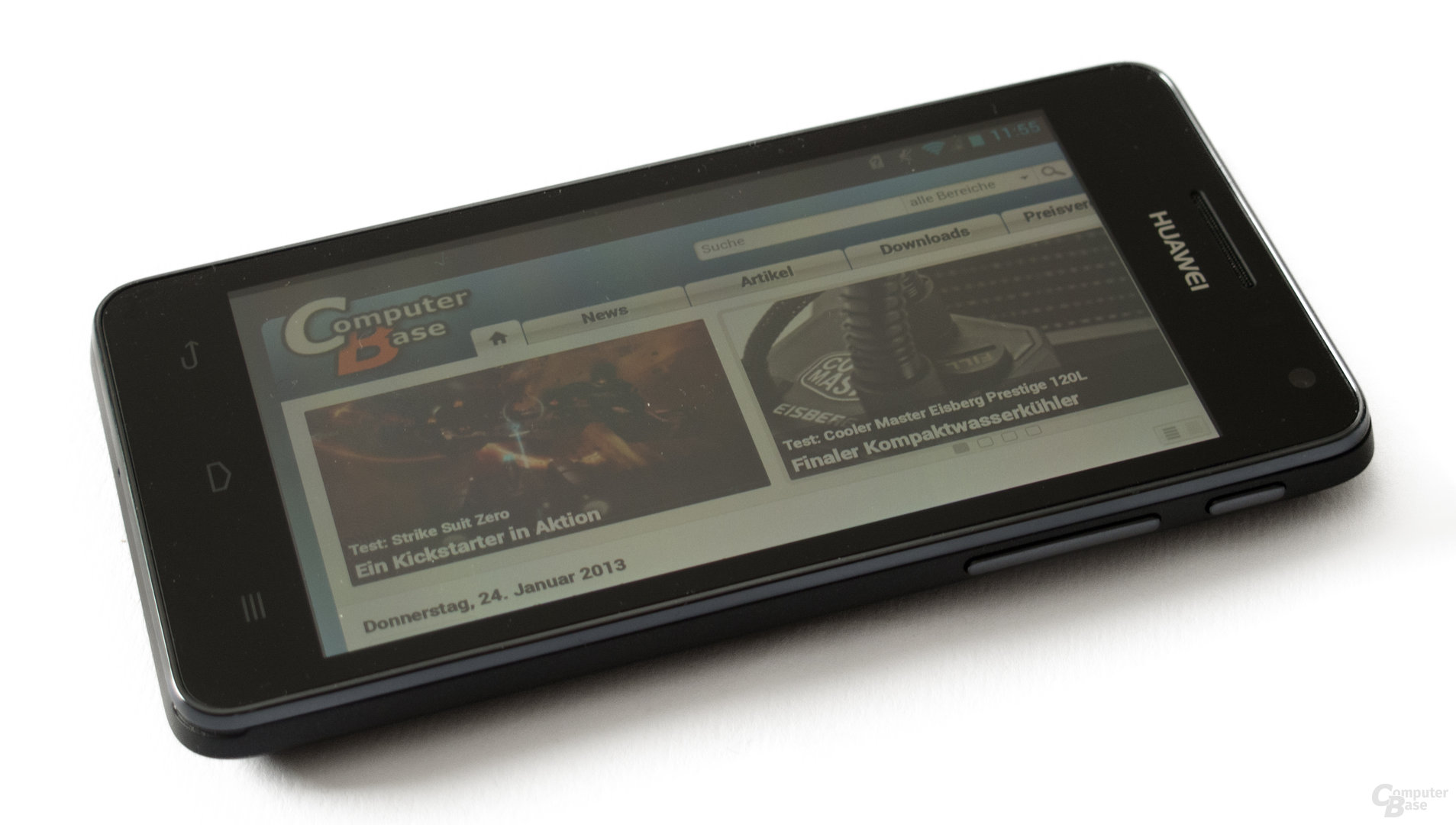Huawei Ascend G 615 im Test: Konkurrenz für das Nexus 4 aus China
3/7Display
Mit weniger als vier Zoll geht kaum noch etwas: Dies scheint angesichts des anhaltenden Trends zu immer größeren Displays eine Tatsache zu sein, der Huawei mit dem G 615 Tribut zollt. Denn obwohl das Ascend G 615 preislich in der Mittelklasse platziert ist, verbauen die Chinesen eine 4,5 Zoll messende Anzeige. Es geht dabei aber nicht nur um die schiere Größe, sondern auch die Qualität der Darstellung. Denn die Basis des Bildschirms ist ein IPS-Panel, das großzügige Blickwinkel sowie eine gute Farbdarstellung verspricht – so auch beim G 615.

Der Punkt Schärfe kommt aber ebenfalls nicht zu kurz. Die Kombination aus Bildschirmdiagonale und 1.280 × 720 Pixeln sorgt für satte 326 ppi. Für das menschliche Auge sind aus normaler Distanz so keine einzelnen Pixel mehr wahrnehmbar. Im Vergleich zu Geräten dieser Preisklasse, die vor gerade einmal einem Jahr auf den Markt gekommen sind, ist dies ein großer Sprung – noch vor wenigen Monaten waren dies reine Oberklassewerte.
Etwas nüchterner fallen die reinen Messwerte aus. Mit einer Maximalhelligkeit von 338 Candela pro Quadratmeter ist das Display nur mittelmäßig hell und so nicht in allen Fällen problemlos nutzbar. Direkte Sonneneinstrahlung sollte man deshalb vermeiden. Darüber hinaus neigt die Anzeige minimal stärker als die zahlreicher anderer aktueller Smartphones zu Spiegelungen. Ebenfalls nur Durchschnitt ist der Kontrast, der bei 938:1 liegt.
In beiden Kategorien bleibt das Ascend G 615 hinter dem Nexus 4, im direkten Vergleich sind die Unterschiede jedoch kaum zu bemerken.
Als optimalen Weißpunkt sehen wir D65 an, also eine Farbtemperatur von 6.500 Kelvin (K). Dies entspricht nach gängiger Definition einem mittlerem Tageslicht und ist der Weißpunkt der gängigen Farbräume sRGB und AdobeRGB. Eine Abweichung von einigen hundert bis etwa 1000 K ist bei Mobiltelefonen als noch akzeptabel anzusehen, einige Displays – bauartbedingt vor allem OLED-Modelle – liegen allerdings beim Weiß und noch mehr bei Grautönen oft im Bereich um 10.000 K, was bereits als deutlicher Blaustich wahrnehmbar ist. Sehr viele Displays von Smartphones und Notebooks treffen zwar den Weißpunkt von 6.500 K relativ genau, weichen aber bei Grautönen und anderen mittleren Farbtönen deutlich mit einem Blaustich ab. Vor allem bei gleichzeitigem Auftreten von Grau und Weiß ist diese ungleichmäßige Graubalance wahrnehmbar.
Gegenüber der LCD-Technik weisen OLED-Bildschirme einige Besonderheiten auf, die sich teilweise in unseren Messungen niederschlagen und erklärungsbedürftig sind. Zum einen ist das der bekanntermaßen hohe Kontrast, der bei OLED durch die selbstleuchtenden Pixel möglich ist – es gibt hier kein Backlight, welches durch das Panel mehr oder weniger stark abgedunkelt wird, sondern ein schwarz angesteuerter Pixel ist tatsächlich komplett schwarz und leuchtet nicht. Da das Kontrastverhältnis den Quotienten zwischen der Helligkeit von Weiß und Schwarz angibt, ergibt die Kontrastmessung bei OLED-Displays theoretisch eine Division durch Null und damit ein nicht definiertes Ergebnis – in der Praxis gibt es bei der Schwarzmessung immer eine gewisse Resthelligkeit durch Streulicht und ein Signalrauschen beim Messgerät, sodass Kontrastergebnisse im fünfstelligen Bereich entstehen. Da die Darstellung dieser Kontrastwerte im Balkendiagramm den irreführenden Eindruck erzeugen, der Kontrast wäre bei OLED sichtbar um viele Größenordnungen besser, haben wir uns entschieden als Kontrast maximal 5000:1 darzustellen und auf diese Erklärung zu verweisen. Im Alltag ist der Unterschied allenfalls in sehr dunklen Umgebungen deutlich wahrnehmbar, bei Tageslicht sind Faktoren wie die Reflexionen der Displayoberfläche wesentlich wichtiger.
Die zweite Besonderheit ist die beim derzeitigen Stand der Technik verhältnismäßig geringe Lebensdauer der blauen Leuchtelemente bei OLED-Displays. Dies veranlasst die Hersteller dazu, zur Steigerung der Lebensdauer bei einigen Displays die klassische RGB-Subpixelmatrix durch alternative Anordnungen abzulösen. Bekannt ist dabei beispielsweise Samsungs „PenTile“-Matrix, deren Hauptmerkmal die Vergrößerung der blauen und roten Subpixel ist – allerdings bei gleichzeitiger Halbierung ihrer Anzahl. Das bedeutet, dass bei gleicher Nennauflösung diese Displays eine geringere Anzahl von Subpixeln aufweisen als Displays mit der bewährten RGB-Matrix. Jeder Pixel verfügt weiterhin über seinen eigenen grünen Subpixel, teilt sich aber den jeweiligen roten und blauen Subpixel mit seinem Nachbarpixel. Das ganze führt bei gleicher Nennauflösung zu einer geringeren tatsächlichen Auflösung und an Kontrastkanten zu Farbsäumen, die vor allem die Lesbarkeit von Text deutlich verringern können.
